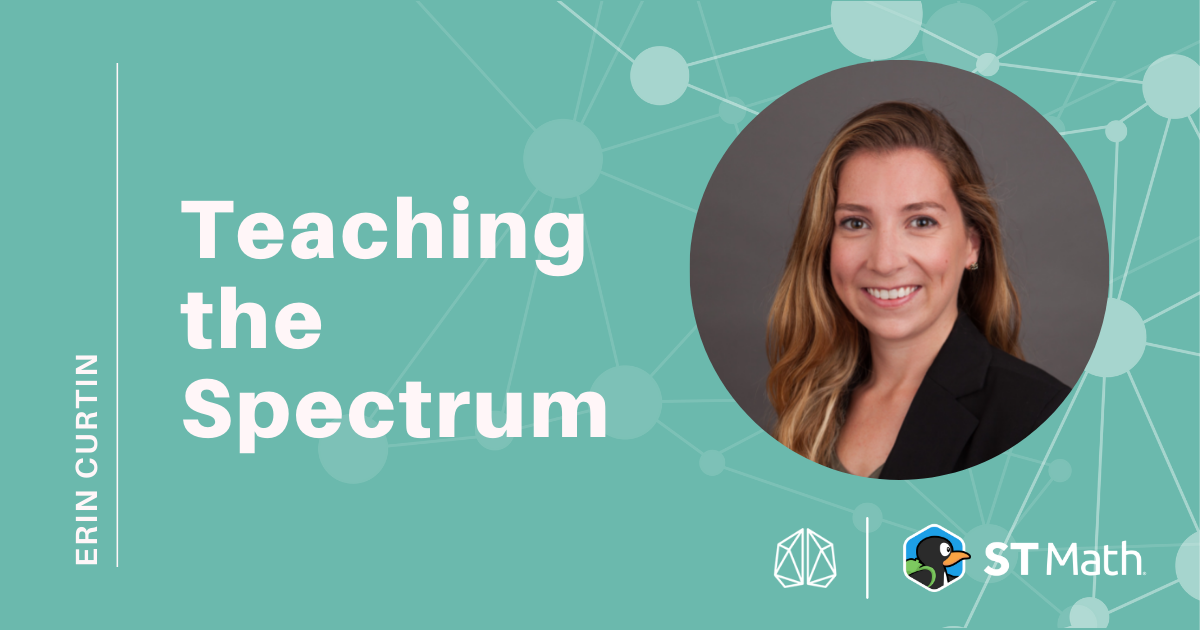

Imagine going through life bearing the weight of a label—seeing the world through different eyes, hungry for self-expression. While the stigma of Autism Spectrum Disorder (ASD) has eroded, young people diagnosed with ASD are at increased risk of school exclusion, especially in traditional math education.
At MIND Research Institute, we believe that regardless of the learning obstacles students may face, all students deserve an equitable opportunity for growth—and that's what our visual-first math software, ST Math, helps to provide.
With ST Math, students learn math based on the neuroscience of how our brains learn. April is known as Autism Acceptance Month and Math Awareness Month. To help us learn more about this month, we sat down with Curriculum Developer and former special education teacher Erin Curtin to talk about her approach to building a life-long love of math for those on the spectrum.
I am from Massachusetts and currently live in Boston. Before joining MIND, I was an elementary special education teacher. I'm certified to teach special education to children with mild to moderate disabilities in pre-K to eighth grade and general education to children in first through sixth grade. I am also licensed to teach general education to children in first through sixth grade. I loved designing my own curriculum for students with special needs, so I went to Vanderbilt to earn my master's degree in learning and design.
During my teaching days, I taught a mix of inclusion, which means I split my time between co-teaching with a general education teacher in their classroom and a resource room where I provided hands-on instruction to small groups of kids. We'd work on grade-level curriculum as well as targeted Individualized Educational Plan (IEP) goals.
I also ran a group for children with emotional disabilities, which focused on increasing their self-regulation skills and emotional awareness, such as responding to stress.
I loved teaching and working with kids, but I often felt that we were missing the mark for students with disabilities. That's why I applied to grad school. I wanted to use my talents and knowledge to make an impact on the curriculum side of things. I wanted to be a lever change.
When I finished my degree, I wanted to work for a mission-driven organization. Working for a nonprofit outside of the school system appeared to be the best way for me to make real change in the educational system at large.
I think there are a lot of things to unpack and address within this question. When we think about students with autism, there's no one kid. Autism is a spectrum, and these kids have unique strengths as well as areas of development.
One of ST Math's key differentiators is that it starts teaching math concepts visually, then gradually layers on symbols and then language. In my experience, I would first begin with materials that kids can touch, move, and manipulate. Once they're familiar with these materials, then we progress to the representational. ST Math is a great tool that fits nicely into that representational category and can easily incorporate manipulatives during the lessons to cement the learning in real time.
Many children with disabilities, but especially students with autism, tend to have difficulties understanding and expressing themselves through language. So when we're working with ST Math, students can solely focus on solving the problem in front of them. They don't need to direct their cognitive efforts to decode the words and symbols.
Finally, my new favorite thing about ST Math, which I think is so powerful for any child on an IEP, is the standards search tool. This is a potent tool for special education teachers because they can see all of the common core standards and associated ST Math objectives for every grade level in one place.
I can quickly identify the skills they know and create an individualized learning path for each kid using the standards to see how the content is interconnected across grade levels. Students on IEPs need that individualized learning journey in the classroom and at home. A student may demonstrate mastery of a particular grade-level concept but may need more practice on another. ST Math allows us to sort and assign curriculum according to those grade-level standards instead of just lowering the grade level all together.
For example, if a child is a fourth grader, they might have fourth-grade skills in place value, but first-grade skills in geometry and second-grade skills in fractions. The goal is to bring them up to those grade-level standards gradually. Using the standards search tool, we can go into their profile, see all of the standards in one place, and create custom learning journeys for each student.
Autism is a spectrum, and one of the primary challenges is identifying and responding to students’ strengths. From a curriculum perspective, a major obstacle for students with autism in mainstream math instruction is that the majority of resources rely on language.
I have a friend right now who's a first-year special education teacher in Connecticut. She's been using ST Math extensively as a way to help her kids develop their independence. When she creates a custom curriculum in ST Math, she essentially gives her kids an opportunity to complete tasks independently and experience that surge in self-esteem from solving a puzzle on their own.
Absolutely. Again, most math instruction uses a language-first approach, like complex word problems. Students need to see themselves in math. Students with autism may not be able to apply a math concept within a word problem to something that they have no schema or background knowledge around. When we remove the emphasis on language from the instruction and the task, we’re going to see students dig deeper into the math and build that deep conceptual understanding.
We need to help students become problem solvers first, and part of that depends on affirming strategy use instead of performance metrics like speed and memorization. It's important that we teach students multiple strategies and affirm whatever method they may choose to use going forward. If one of my kids wants to use a number line forever and that works for them, I'm not going to force them into a box of utilizing another strategy for the sake of variety.
One of the essential things every special education teacher should care about is equity. We need to ensure we're giving everybody what they need to be successful, and that's going to look different for every kid.
I base my interactions with colleagues, schools, friends, and everybody else on the notion that we all have different strengths and areas of need. When designing lesson plans, teachers should think about making the lesson accessible to all learners. Ask yourself: how can we make our actions more impactful for every child? After all, that's MIND's mission: to ensure that all students are mathematically equipped to solve the world's most challenging problems.
If you would like to hear success stories on how ST Math helps students receiving special education and more, subscribe to our blog.

Parker Erickson was MIND’s Content and Community Specialist. As a digital storyteller, Parker is passionate about building strong communities through technology and social media. Off the clock, you can find him buried in the latest issue of The New Yorker or experiencing different cultures through food.
Comment